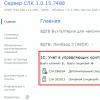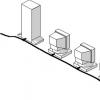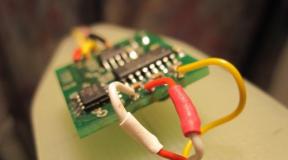Amplitude-frequency spectrum of the Fourier series. Amplitude spectrum of the signal. Amplitude-frequency response (AFC). Properties of the spectrum of a periodic sequence of rectangular pulses
Any signal can be decomposed into components. This signal decomposition is called spectral. In this case, the signal can be represented as a graph of the dependence of signal parameters on frequency; such a diagram is called a spectral diagram or spectrum of the signal.
The signal spectrum is a set of simple signal components with certain amplitudes, frequencies and initial phases.
There is a strict relationship between the spectrum of a signal and its shape: a change in the shape of the signal leads to a change in its spectrum and vice versa, any change in the spectrum of the signal leads to a change in its shape. This is important to remember, because when transmitting signals in a transmission system, they undergo transformations, which means their spectra are transformed.
There are two types of spectral diagrams:
— spectral diagram of amplitudes;
— spectral phase diagram.
In the amplitude spectral diagram, all components are displayed with their amplitudes and frequencies.
In the spectral phase diagram, all components are displayed with their initial phases and frequencies.
Any signal has one spectral amplitude diagram and one spectral phase diagram, which may contain many components.
Regardless of what the spectrum is (amplitudes or phases), it is depicted in the form of many lines - components. In the amplitude spectrum, the height of the spectral line is equal to the amplitude of the signal component, and in the phase spectrum, it is equal to the initial phase of the component. Moreover: in the amplitude spectrum, all components have positive values, and in the phase spectrum, both positive and negative. If the amplitude of the spectral component has a negative sign, then in the amplitude spectrum it is taken modulo, and in the phase spectrum the sign of the component changes to the opposite.
Classification of signal spectra.
1. Spectra vary in type discrete(ruled) or solid.
A discrete spectrum is one in which individual components can be distinguished.
A spectrum is continuous, in which individual components cannot be distinguished, since they are located so close that they merge with each other.
2. By frequency range distinguish spectra limited And unlimited.
A limited spectrum is one in which all the signal energy (all spectral components) are in a limited frequency range (fmax ? ?).
An unlimited spectrum is one in which all the signal energy is in an unlimited frequency range (fmax ? ?). In practice, such spectra are limiting.
Spectral representation of periodic signals
1. Harmonic oscillation.
The mathematical model of harmonic oscillation has the form:
u(t)=Ums sin (?st+?s) (11)
As can be seen from the mathematical model, the spectrum of this vibration contains one harmonic component, which is located at frequency?s. The height of the component in the amplitude spectrum is equal to the vibration amplitude Ums, and in the phase spectrum - to the initial phase of the vibration?s. Moreover, when constructing the spectrum, it is necessary to take into account the connection between the time diagram of the signal and the amplitude spectrum. The amplitude of the spectrum component must correspond in height to the amplitude of the oscillation on the time diagram.
It should be noted that as the signal frequency increases, its component will move away along the frequency axis from zero (Figure 13).
Figure 13 - Spectral representation of harmonic oscillations
As can be seen from the figures, the spectrum of harmonic vibration is discrete and limited.
2. Periodic, non-harmonic signals.
The main feature of the spectral representation of such signals is the presence of many spectral components in their spectrum. Such signals can be described by a Fourier series, according to which:  that is, the signal can be represented by the sum of a constant component and many harmonic components.
that is, the signal can be represented by the sum of a constant component and many harmonic components.
Let's transform this series using the trigonometric property
sin(x+y) = sin x cos y + cos x sin y (13)
Assuming that x=?k and y=k?ct we get:
Since Umk and?k are parameters of the series, they can be denoted by coefficients
Umk sin? k = ak; Umk cos ?k = bk (15)
Then the series will look like:
The parameters of the series can be determined through the coefficients ak and bk:
where k=1, 2, 3…
The amplitude of the DC component and coefficients can be determined through the signal value u(t):
 It follows from the series that if the described signal is an even function f(t)=f(-t), then the series will have only cosine components, since bk=0, if the function is odd (f(t) ? f(-t) ), then the rad contains only sinusoidal components (ak=0).
It follows from the series that if the described signal is an even function f(t)=f(-t), then the series will have only cosine components, since bk=0, if the function is odd (f(t) ? f(-t) ), then the rad contains only sinusoidal components (ak=0).
Let's consider the spectral representation of periodic, non-harmonic signals using the example of a periodic sequence of rectangular pulses (PPPS).
When constructing a spectrum, it is necessary to calculate the following parameters:
a) signal duty cycle:
b) the value of the constant component:
c) the frequency of the first harmonic of the spectrum, which is equal to the signal frequency:
d) amplitudes of the harmonic components of the spectrum:
 When constructing the spectrum, it is necessary to note the following features:
When constructing the spectrum, it is necessary to note the following features:
1. All harmonic components are at frequencies that are multiples of the first harmonic frequency (2?1, 3?1, 4?1, etc.);
2. For the amplitude spectrum:
a) the SATR spectrum has a lobe-like character, i.e., many “lobes” can be distinguished in the spectrum;
b) the number of harmonic components in the lobe depends on the duty cycle and is equal to q - 1;
c) the amplitudes of harmonic components located at frequencies that are multiples of the duty cycle are equal to zero;
d) the shape of the spectrum is indicated by the envelope - dotted line, smoothly connecting the vertices of the harmonic components;
e) the point from which the envelope emanates is equal to 2U0 or 2I0.
3. For the phase spectrum:
a) all harmonic components, at frequencies not multiples of the duty cycle, have the same height, equal to?/2 (90°);
b) all harmonic components in one petal have the same sign, and in neighboring ones they have the opposite sign.
c) components at frequencies that are multiples of the duty cycle have an initial phase equal to zero.
The SATR spectra with duty cycle q=3 are presented in Figure 14.
As can be seen from the diagrams, the spectrum of AEFI is discrete and unlimited. Therefore, the frequency range within which the first two lobes are located is taken as the width of the spectrum, since they contain about 95% of the signal energy:
Fs = 2/?i. (26)

Figure 14 - Spectral representation of SAI: a) time diagram; b) spectral diagram of amplitudes; c) spectral phase diagram
As can be seen from the formula, the width of the SATR spectrum depends only on the pulse duration and does not depend on its period.
3. Non-periodic signals.
Since it is impossible to distinguish a period in non-periodic signals, because T??, it is impossible to calculate and construct the spectrum using the same method as for periodic signals. However, it is necessary to know the spectrum of such signals, since all information signals are non-periodic. To construct the spectrum of a non-periodic signal, the following procedure is performed: the signal is mentally represented as periodic with an arbitrary period, for which the spectrum is constructed. Then the limit transition is carried out, directing the period to infinity (T??) (Figure 15). In this case, the frequency of the first harmonic and, accordingly, the distance between the harmonic components tends to zero (f1=1/T), so all components merge with each other and form a continuous spectrum.

Figure 15 - Pulse signal u(t) and its representation as a periodic signal
The shape of the spectrum of non-periodic signals is indicated by an envelope (solid line) (Figure 16).

Figure 16 - Spectral diagram of a non-periodic signal
The Fourier series for such signals also cannot be written, since in this case the amplitude of the constant component and the coefficients ak and bk are equal to zero. In this case, the value of the signal at any time is also zero, which is not true. Therefore, Fourier transforms are used for such signals:
 Expression (27) is an inverse transformation, and (28) a direct Fourier transform.
Expression (27) is an inverse transformation, and (28) a direct Fourier transform.
The quantity S(?) is the complex spectral density of the non-periodic signal u(t). It is equal to:
S(?) = S(?)e ^(-j?(?)) (29)
where S(?) is the spectral density of amplitudes or the amplitude spectrum of a non-periodic signal, and?(?) is the phase spectrum of a non-periodic signal.
Spectral density of amplitudes of a non-periodic signal at any frequency? equal to the total amplitude of the components located in the small band?? in the vicinity of the frequency? converted to 1 Hertz.
Time diagrams and amplitude spectral densities for rectangular and triangular pulses are presented in Figure 18:

Figure 18 - Spectral representation of non-periodic signals: a) rectangular pulse; b) triangular pulse
The set of harmonics that form the Fourier series (4.10) in trigonometric form is called spectrum of a periodic signal, and the sets of amplitudes Umk and the initial phases of these harmonics - spectra amplitudes and phases. Each harmonic:
![]()
can be displayed with two vertical lines. To do this, on one frequency axis it is necessary to plot the frequency value of this harmonic and draw a vertical line with a height equal to the amplitude of the harmonic, then on the other frequency axis at the frequency of the same harmonic, draw a second vertical line equal in height to the initial phase of the harmonic.
The Fourier series (4.3) can be rewritten as

Considering that the cosine function is periodic with period 2 = 360°, i.e. its values are repeated every 360°; an integer number of periods can be subtracted from the phase of the harmonic components. Then we get another form of writing series (4.3):

These series can be depicted graphically. The harmonics of this signal, included in formula (4.3), are shown in the timing diagrams in Fig. 4.1, b-d. Another way to graphically represent the components of the Fourier series for a signal in Fig. 4.1, and shown in Fig. 4.5, A–V. The harmonic amplitudes decrease according to the law , Where P- the number of the harmonic, and the phases of the harmonics change according to the law n where is the phase of the first harmonic.
For a periodic sequence of rectangular pulses shifted by a quarter of the period (Fig. 4.3, A) the Fourier series formula (4.6) can be modified if we remember that the minus sign in front of a harmonic oscillation means a phase rotation of the oscillation by 180°:

Rice. 4.5. Amplitudes and phases of signal harmonics (4.12) and (4.13)
The initial phases of oscillations in series (4.14) alternately take values 0 and 180°. A graphical representation of series (4.14) is given in Fig. 4.5, a and b.
Vertical lines in Fig. 4.5 and 4.6 were named spectral lines, and the sets of these lines, or, what is the same, the sets of phase harmonic amplitudes in (4.10), form amplitude and phase spectra of this signal.

Rice. 4.6. Amplitudes and phases of signal harmonics (4.14)
Radio engineers are familiar with instruments - spectrum analyzers, which respond to each harmonic that is part of a signal of a complex shape and allow them to be measured.
Thus, the amplitude spectrum is a set of harmonic amplitudes , , , ... (including constant and fundamental components) included in the Fourier series, written in trigonometric form (4.10), and the phase spectrum is a set of initial phases,, ... of these harmonics. The complex amplitudes from (4.12) form the complex spectrum of the signal u(t).
Analysis of the spectral (harmonic) composition of periodic signals is the calculation of the amplitudes and initial phases of the harmonic components of the Fourier series. Typically, to calculate these quantities, the form of writing the Fourier series (4.2) is used:
Let us show that the notation form (4.15) equivalent notation form (4.7).
From the above reasoning it follows that to analyze the spectral composition of a signal it is enough to know how to calculate the quantities , U" mn And U’ mn in expression (4.15).
From formulas (4.2) we know that the constant component of the series is calculated as the average value of the function:
![]()
Odds U" mk And U"" mk calculated as weighted averages with weights cos k and sin respectively:
![]()
![]()
Because the, ![]() That
That
Using Euler's formula
We finally obtain the expression for the complex spectrum of the signal:
![]()
The signal spectrum is affected not only by the signal shape, but also by its parameters. It is best to consider this effect using a specific example, and most simply, using the example of a periodic sequence of rectangular pulses. In a fairly general case, this sequence is shown in Fig. 4.7, A. The pulse repetition period is indicated T", and the ratio of the period to the pulse duration is called duty cycle and designate.
Calculating the coefficients of the Fourier series in trigonometric form using formulas (4.16) - (4.18) leads us to the entry (see Table 4.1)
Where U 0 =U/ q And


Rice. 4.7. Periodic sequence of rectangular pulses with duty cycle q= 3 and its spectrum
The amplitude spectrum of such a periodic sequence with duty cycle q= 3 is shown in Fig. 4.7, b.
With values k, multiples of duty cycle q pulse sequence, the function takes zero values and harmonics with these numbers have zero amplitudes (in our example with k= 3,6, 9, ...). The frequency of the first harmonic is determined by the formula
For harmonics with numbers k, for which the amplitude is positive, the phase angle is zero; for harmonics with numbers k, for which the value turns out to be negative, the phase angle takes the value 180° (Fig. 4.7, c).
Let us consider the influence on the spectrum of a sequence of rectangular pulses of such parameters as the period and duration of the pulse.
The frequency of the fundamental harmonic depends primarily on the period, i.e. its location in the spectrum. If we, for example, increase the period of the pulse sequence (Fig. 4.7, A), then the frequency of the first harmonic will decrease.
This will lead to thickening of the spectral lines (Fig. 4.8, b And V). The duty cycle of the pulses will also increase with increasing period (in our example q= 5), therefore, harmonics with higher numbers, multiples of q (k= 5, 10, 15, ...). The amplitudes of all harmonics will decrease.

Rice. 4.8. Sequence of rectangular pulses with duty cycle q= 5 and its spectrum
On the other hand, if the sequence period is left unchanged (for example, ), and the pulse duration, say, is reduced (for example, to a value , as in fig. 4.9, A), then the first harmonic will not change its location in the signal spectrum. As the duty cycle increases, harmonics with numbers divisible by them will go to zero, as before. q (in Fig. 4.8, b at k= 5,10,15,… ).

Rice. 4.9. The influence of pulse duration on the signal spectrum

Rice. 4.10. The influence of pulse duration and repetition period on the signal spectrum
In Fig. 4.10 shows the case when both the period and duration of the pulse were changed. We invite readers to analyze this situation for themselves. Examples of solving problems for calculating periodic signals are also given in.
Although we have analyzed rather particular examples, characteristic behavior of the spectrum is also observed for other types of periodic pulse sequences. It consists of the following:
As the sequence period increases T the frequency of the first harmonic decreases and the spectral lines become denser; on the contrary, as the period decreases, the frequency of the first harmonic increases and the spectral lines become rarer;
The shorter the pulses in the sequence, the slower they decrease with increasing number P harmonic amplitudes; on the contrary, the wider the pulses, the faster the amplitudes of higher harmonics decrease.
The main provisions of the materials set out in clause 4.2.
Not long ago, Comrade Makeman described how, using spectral analysis, you can decompose some sound signal to the notes that compose it. Let's abstract a little from sound and assume that we have some digitized signal, the spectral composition of which we want to determine quite accurately.
Under the cut short review a method for extracting harmonics from an arbitrary signal using digital heterodyning, and a little special Fourier magic.
So, what do we have?
File with samples of a digitized signal. It is known that the signal is a sum of sinusoids with their own frequencies, amplitudes and initial phases, and possibly white noise.
What do we do.
Use spectral analysis to determine:
- the number of harmonics in the signal, and for each: amplitude, frequency (hereinafter in the context of the number of wavelengths per signal length), initial phase;
- presence/absence of white noise, and if present, its standard deviation (standard deviation);
- presence/absence of a constant signal component;
- put all this into a beautiful PDF report with blackjack and illustrations.
We'll decide this task in Java.
Materiel
As I already said, the structure of the signal is known: it is the sum of sinusoids and some kind of noise component. It so happened that for the analysis of periodic signals in engineering practice they widely use a powerful mathematical apparatus, generally referred to as "Fourier analysis" . Let's take a quick look at what kind of animal this is.A little special, Fourier magic
Not so long ago, in the 19th century, the French mathematician Jean Baptiste Joseph Fourier showed that any function that satisfies certain conditions (continuity in time, periodicity, satisfaction of Dirichlet conditions) can be expanded into a series, which later received his name - Fourier series .In engineering practice, the expansion of periodic functions into a Fourier series is widely used, for example, in circuit theory problems: a non-sinusoidal input action is expanded into the sum of sinusoidal ones and calculated required parameters chains, for example, using the superposition method.
There are several possible options for writing the coefficients of the Fourier series, but we just need to know the essence.
Fourier series expansion allows you to expand a continuous function into a sum of other continuous functions. And in general, the series will have an infinite number of terms.
A further improvement of the Fourier approach is the integral transformation of its name. Fourier transform
.
Unlike the Fourier series, the Fourier transform expands a function not into discrete frequencies (the set of frequencies of the Fourier series for which the expansion is, generally speaking, discrete), but into continuous ones.
Let's take a look at how the coefficients of the Fourier series relate to the result of the Fourier transform, called, in fact, spectrum
.
A small digression: the spectrum of the Fourier transform is, in general, a complex function that describes complex amplitudes
corresponding harmonics. That is, the spectrum values are complex numbers whose modules are the amplitudes of the corresponding frequencies, and the arguments are the corresponding initial phases. In practice, they are considered separately amplitude spectrum
And phase spectrum
.

Rice. 1. Correspondence between the Fourier series and the Fourier transform using the amplitude spectrum as an example.
It is easy to see that the coefficients of the Fourier series are nothing more than the values of the Fourier transform at discrete times.
However, the Fourier transform compares a time-continuous, infinite function with another, frequency-continuous, infinite function - the spectrum. What if we do not have a function that is infinite in time, but only some part of it that is recorded and discrete in time? The answer to this question is given by further development Fourier transform - discrete Fourier transform (DFT) .
The discrete Fourier transform is designed to solve the problem of the need for continuity and infinity in time of the signal. Essentially, we believe that we have cut out some part of the infinite signal, and the rest of the time domain we consider this signal to be zero.
Mathematically, this means that, having a function f(t) that is infinite in time, we multiply it by some window function w(t), which vanishes everywhere except for the time interval of interest to us.
If the “output” of the classical Fourier transform is a spectrum – a function, then the “output” of the discrete Fourier transform is a discrete spectrum. And samples of a discrete signal are also supplied to the input.
The remaining properties of the Fourier transform do not change: you can read about them in the relevant literature.
We only need to know about the Fourier transform sine wave, which we will try to find in our spectrum. In general, this is a pair of delta functions that are symmetrical about zero frequency in the frequency domain.

Rice. 2. Amplitude spectrum of a sinusoidal signal.
I have already mentioned that, generally speaking, we are not considering the original function, but some product of it with the window function. Then, if the spectrum of the original function is F(w), and the window function is W(w), then the spectrum of the product will be such an unpleasant operation as the convolution of these two spectra (F*W)(w) (Convolution Theorem).
In practice, this means that instead of a delta function, we will see something like this in the spectrum:

Rice. 3. Spectrum spreading effect.
This effect is also called spectrum spreading
(eng. spectral leekage). And the noise that appears due to spectrum spreading, accordingly, side lobes
(English sidelobes).
To combat side lobes, other, non-rectangular window functions are used. The main characteristic of the "efficiency" of a window function is side lobe level
(dB). Pivot table Sidelobe levels for some commonly used window functions are shown below.
The main problem in our problem is that side lobes can mask other harmonics lying nearby.

Rice. 4. Separate harmonic spectra.
It can be seen that when adding up the given spectra, the weaker harmonics seem to dissolve into the stronger one.

Rice. 5. Only one harmonic is clearly visible. Not good.
Another approach to combating spectrum spreading is to subtract from the signal the harmonics that create this spreading.
That is, having established the amplitude, frequency and initial phase of the harmonic, we can subtract it from the signal, while we also remove the “delta function” corresponding to it, and along with it the side lobes generated by it. Another question is how to accurately find out the parameters of the desired harmonic. It is not enough to simply take the required data from the complex amplitude. Complex spectrum amplitudes are formed at whole frequencies, however, nothing prevents a harmonic from having a fractional frequency. In this case, the complex amplitude seems to blur between two adjacent frequencies, and its exact frequency, like other parameters, cannot be established.
To establish the exact frequency and complex amplitude of the desired harmonic, we will use a technique widely used in many branches of engineering practice - heterodyning .
Let's see what happens if we multiply the input signal by the complex harmonic Exp(I*w*t). The signal spectrum will shift by an amount w to the right.
We will take advantage of this property by shifting the spectrum of our signal to the right until the harmonic becomes even more reminiscent of the delta function (that is, until some local signal-to-noise ratio reaches a maximum). Then we will be able to calculate the exact frequency of the desired harmonic, as w 0 – w het, and subtract it from the original signal to suppress the effect of spectrum spreading.
An illustration of the spectrum variation depending on the local oscillator frequency is shown below.

Rice. 6. Type of amplitude spectrum depending on the local oscillator frequency.
We will repeat the described procedures until we cut out all the harmonics present, and the spectrum will not remind us of the spectrum of white noise.
Then, we need to estimate the standard deviation of white noise. There are no tricks here: you can simply use the formula to calculate the standard deviation:

Automate it
It's time to automate harmonic extraction. Let's repeat the algorithm one more time:1. We are looking for a global peak in the amplitude spectrum, above a certain threshold k.
1.1 If you haven’t found it, let’s finish
2. By varying the local oscillator frequency, we look for a frequency value at which the maximum of a certain local signal-to-noise ratio will be achieved in a certain vicinity of the peak
3. If necessary, round off the amplitude and phase values.
4. Subtract from the signal a harmonic with the found frequency, amplitude and phase minus the local oscillator frequency.
5. Go to point 1.
The algorithm is not complicated, and the only question that arises is where to get the threshold values above which we will look for harmonics?
To answer this question, the noise level must be assessed before cutting out the harmonics.
Let's construct a distribution function (hello, mathematical statistics), where the abscissa axis will be the amplitude of the harmonics, and the ordinate axis will be the number of harmonics that do not exceed in amplitude this very value of the argument. An example of such a constructed function:

Rice. 7. Harmonic distribution function.
Now we will also construct a function - the distribution density. That is, the values of finite differences from the distribution function.

Rice. 8. Density of the harmonic distribution function.
The abscissa of the maximum distribution density is the amplitude of the harmonic occurring in the spectrum the greatest number of times. Let's move some distance away from the peak to the right, and consider the abscissa of this point to be an estimate of the noise level in our spectrum. Now you can automate it.
Look at a piece of code that detects harmonics in a signal
public ArrayList
heterodinParameter.setProperty("frequency", heterodinSelected);
heterodinParameter.synthesizeIn(heterodin); heterodinedSignal.set(cutter.getCurrentSignal()).multiply(heterodin); spectrum.recalc();parameter.setProperty("amplitude", MathHelper.adaptiveRound(spectrum.getRealAmplitude(harmonic)));
parameter.setProperty("frequency", harmonic - heterodinSelected);
parameter.setProperty("phase", MathHelper.round(spectrum.getPhase(harmonic), 1)); cutter.addSignal(parameter); cutter.cutNext();
The term "quasi-static" means "almost unchanged" and therefore refers to a signal that changes unusually slowly over a long period of time. It has characteristics more similar to static alerts (persistent) than dynamic ones.

Periodic signals
These are the ones that are accurately repeated on a regular basis. Examples of periodic waveforms include sine, square, sawtooth, triangle, etc. The nature of a periodic waveform indicates that it is identical at similar points along a time line. In other words, if the time line advances exactly one period (T), then the voltage, polarity, and direction of the waveform change will repeat. For the voltage waveform, this can be expressed by the formula: V (t) = V (t + T).
Repeated signals
They are quasi-periodic in nature, so they have some similarities to a periodic waveform. The main difference between them is found by comparing the signal at f(t) and f(t+T), where T is the warning period. Unlike periodic alerts, in repeating sounds these points may not be identical, although they will be very similar, as will the overall waveform. The alert in question may contain either temporary or stable symptoms, which vary.

Transient signals and pulse signals
Both types are either a one-time event or a periodic event in which the duration is very short compared to the period of the waveform. This means that t1<<< t2. Если бы эти сигналы были переходными процессами, то в радиочастотных схемах намеренно генерировались бы в виде импульсов или переходного режима шума. Таким образом, из вышеизложенной информации можно сделать вывод, что фазовый спектр сигнала обеспечивает колебания во времени, которые могут быть постоянными или периодическими.
Fourier series
All continuous periodic signals can be represented by a fundamental sine wave of frequency and a set of cosine harmonics that sum linearly. These vibrations contain swell forms. An elementary sine wave is described by the formula: v = Vm sin(_t), where:
- v - instantaneous amplitude.
- Vm - peak amplitude.
- "_" - angular frequency.
- t - time in seconds.
The period is the time between repetitions of identical events or T = 2 _ / _ = 1 / F, where F is the frequency in cycles.

The Fourier series that makes up the waveform can be found if a given quantity is decomposed into its component frequencies, either by a bank of frequency-selective filters or by a digital signal processing algorithm called fast transform. The method of building from scratch can also be used. The Fourier series for any waveform can be expressed by the formula: f(t) = a o/2+ _ n -1 )



















